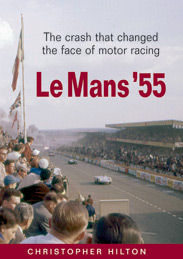
LeMans'55
by Christopher Hilton
Book
Review by Ed Potkai
At the 1955 Le Mans endurance race, a
Jaguar passed an Austin Healey then braked sharply for a
pit stop. The Healey swerved left into the path of a
faster Mercedes. The Mercedes collided with the Healey,
then launched into a spectator area, killing more than
80 people in addition to driver Pierre "Levegh".
This book is subtitled "The crash that changed the face
of motor Racing". It focuses entirely on the disaster,
its prelude, and its aftermath. The race winner is
mentioned only in relation to the consequences. Most
motorsports fans know of the incident but only vaguely.
This book makes the tragedy and the people involved very
real.
Whether the Titanic, Pearl Harbor, or
9/11, there is something about books which count down to
inevitable doom. They start slowly by describing
background. Then as fate approaches, we read faster,
all the time hoping that somehow it can be avoided.
Hilton leads us well. He's not afraid to use style to
keep us in the moment. He does not always use complete
sentences and can employ repetition for dramatic
effect.
After the crash has been described, the
pace of the book slows. No longer "exciting", it
becomes a lesson in good detective work. The author
analyzes the links in the "chain" of events and
circumstances that contributed to the disaster. The
work is well researched and documented. Hilton analyzes
the "facts", many of them conflicting, many biased, many
impossible. He respects that the witnesses did their
best to remember, but is not afraid to point out when
someone might have a reason to recall a prejudiced
version. And his clear bottom line is that no one truly
knows.
The author asks himself would he be able
to present his case to the three drivers if they were
standing alive before him. He concludes that he would.
And we too believe the evidence is presented as fairly
as humanly possible.
Was someone to blame or was it just a
"racing accident"? Having presented the evidence, the
author leaves the reader to draw his own judgement.
Although British himself, Hilton does not fault the
Frenchman or the Germans. He never makes a declarative
statement of blame. But the last sentence of chapter
eight leaves little doubt about his personal conclusion.
This book was written fifty years after
the incident. The author takes pains to remind us that
it was a much different time. Many of the actions taken
may seem callous. But virtually everyone at the track
that day had survived a terrible war only ten years
previous. British, French, or German, they had watched
their countries endure much destruction. They had all
seen days when 80 deaths was a tiny number. Death was
inevitable, especially in motor racing. Only three
months later, the Austin Healey driver crashed out of a
race in which three drivers burned to death.
Why would the author examine the accident
fifty years after the fact? The safety lessons have
long ago been implemented (however slowly). By
uncovering the facts and emotions, I think he wanted to
reach an understanding and to change a statistic into a
reality for us. And that is the reason we should read
it.
With such a sharp focus, this is not a
book for everyone. It presents dozens of names which
can be difficult to track. The graphics are adequate
but quite basic. Occasional sentences can be awkward to
read (look who's talking!). But this is a very fine
history which will fascinate many.
Postscript:
The driver who was waiting to relieve Levegh was
Connecticut's John Fitch. Within the year, Fitch
designed the Lime Rock Park race course. His top
priority was that no race car would ever invade a
spectator area. In more than fifty years at Lime Rock,
none has.
|